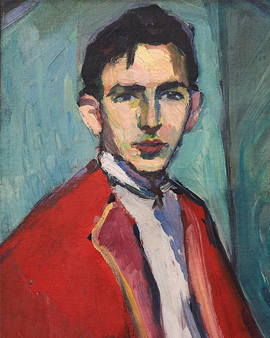Hermann Stenner's name would probably be mentioned today in the same breath as those of other well-known artists of German Expressionism, if his life had not come to an abrupt end as a soldier right at the beginning of the First World War. The German painter, graphic artist, and art theorist Willi Baumeister, who survived both world wars, even suggested that Stenner would have become one of Germany's best painters "if the senseless, criminal war had not taken its victims." Only five productive years of his short life were granted to Stenner, in which he created the impressive number of at least 300 paintings and a good 1500 graphics. In a rapid development he went through the positions of impressionism in the beginning, let himself be inspired by Kandinsky on the colorfulness and intensity of expressionism, to finally transition into a strongly abstracting painting style.
As the son of a master painter, he grew up with paint and brushes, so to speak, and tentatively attended the Handwerker- und Kunstgewerbeschule in Bielefeld before being accepted at the Kunstakademie in Munich. A year later he moved to the Royal Academy of Fine Arts in Stuttgart, where he was decisively influenced by Adolf Hölzel, the pioneer of modernism, and was allowed to move into a master-class studio. At the age of 22 he took part in the first Expressionist exhibition for Germany in Dresden and shortly afterwards Adolf Hölzel involved him in the execution of epochal wall frescoes for the Werkbund exhibition in Cologne. He executed these together with Oskar Schlemmer (who later taught at the Bauhaus) and Willi Baumeister. This groundbreaking Werkbund exhibition, which had the quality and scope of a world exhibition, was halted prematurely by the beginning of World War I. Stenner volunteered together with Schlemmer in August and died only half a year later in the battle of Ilow in Poland.
The art historian and contemporary of Stenner, Hans Hildebrandt, reported about him: "Nature gave Stenner as a precious gift the lightness of hand, the early mastery of craftsmanship. It lent his paintings and drawings the freshness of the immediate, the impression of the joyfully effortlessly created, to which his temperament and his delight in being in a vivid play of colors rich in contrasts contributed."
This self-confidence and immediacy are impressively concentrated in Stenner's "Self-Portrait with Red Jacket". At the same time, the artist's short life span brings to mind the radical incision of the war, which abruptly halted countless careers, life plans, and artistic developments or caused them to veer off in a different direction that no longer offered any room for joie de vivre.
×





.jpg)
.jpg)
.jpg)
.jpg)
.jpg)
.jpg)
.jpg)
.jpg)
.jpg)
.jpg)
.jpg)
.jpg)
.jpg)
.jpg)
.jpg)
.jpg)
.jpg)
.jpg)
.jpg)
.jpg)
.jpg)
.jpg)
.jpg)
.jpg)
.jpg)
.jpg)
_-_(MeisterDrucke-693707).jpg)
_-_(MeisterDrucke-693707).jpg)
.jpg)
.jpg)
.jpg)
.jpg)
.jpg)
.jpg)
.jpg)
.jpg)
.jpg)
.jpg)
.jpg)
.jpg)
.jpg)
.jpg)
.jpg)
.jpg)






